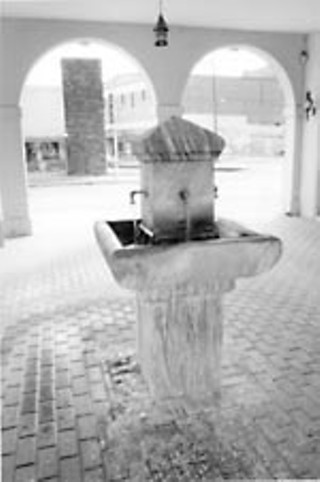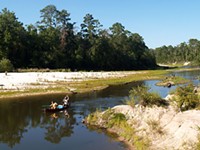Day Trips
The hot mineral waters of Marlin still flow from the fountain under the public pavilion
By Gerald E. McLeod, Fri., Feb. 18, 2005

The hot mineral waters of Marlin still flow from the fountain under the public pavilion a couple of blocks east of the Falls County Courthouse. For nearly 60 years the curative properties of the smelly, harsh-tasting water attracted visitors to what was once a world-class resort city southeast of Waco.
"What a welcome blessing it is to discover a mineral water that when taken internally functions to promote the natural elimination of body waste ... and when administered in the form of hot mineral water baths, draws through the pores of the skin, the sluggish impurities that clog the blood stream," read a magazine article of the early 1900s.
"A cup or two of the water and in about 45 minutes you'll need to relieve yourself," says Dr. James Bryan, a member of the Falls County Historical Commission and a local dentist. "That stuff will really clean you out."
Dr. Bryan says the water has about the same chemical compound as Epsom salt and is a natural laxative. Dr. Bryan grew up in Marlin and saw the last gasps of a once thriving industry. "Antibiotics put them out of business," he says of the health spas.
The mineral water was discovered under the farming community by accident in 1892. Instead of drinking water, the new well produced a gusher of 147-degree water containing large amounts of sodium, sulphur, magnesium, iron, and other minerals.
Just how the curative effects of the water were discovered is shrouded in the fog of time. Dr. Bryan says that the town folks noticed that mangy dogs that rolled in the water became cured. Another story says that a drifter who had nowhere else to bathe but in the mineral well's runoff had skin lesions healed after a few days.
Before the first substantial bathhouse was built in 1895, Marlin was already a medical center. "Waco didn't have a hospital at the time, and Marlin had two," Dr. Bryan says. Local doctors began using the mineral water to treat their patients.
The tubs of the Marlin Sanitarium and other bathhouses attracted thousands of the inflicted, as well as "health vacationers." There was even a bathhouse that was owned by and catered to African-Americans. Patrons purchased three-day or weeklong passes to the 6-foot-long, 2-foot-deep porcelain tubs. The tickets allowed two baths a day administered by a doctor, plus use of saunas and steam baths. Each treatment took two to three hours, Dr. Bryan says.
Between treatments, visitors were looking to take advantage of their revived health, and the merchants of Marlin were happy to accommodate. You wouldn't know it to look at Marlin now, but it was "a party animal" back then, says Dr. Bryan.
The grand Arlington Hotel was as fancy as anything in Hot Springs, Ark. The Majestic Hotel offered 125 rooms and private access to their own bathhouse. Conrad Hilton arrived in town late, but still in time to profit from the eighth hotel in his growing chain of hotels.
Top entertainers of the day worked and rested in Marlin, and big-name bands played Dallas or Houston on the weekend and Marlin during the week. Several professional baseball teams held spring training in town, but the New York Giants returned the most. In the 11 years the Giants came to Marlin (beginning in 1908), they won three pennants.
The opulent Arlington Hotel was dismantled in the 1930s and the bricks used to build a high school and gymnasium. By the Seventies the number of visitors to the baths completely dried up. Of the grand hotels, only the seven-story Hilton on Coleman Street remains – a shell of what it was during its heyday. The last of the bathhouses burned around 1990.
The most visible sign of Marlin's glory days is the Municipal Hygeia, now partially enclosed to house the visitors center at 245 Coleman St. Visitors once gathered on benches under the pavilion to sip the curative waters from the original well. After more than 100 years, the fountain still flows, and long tubs provide free foot baths. For a walking tour of the historic sites of "Mineral Water City of Texas," call the chamber at 254/803-3301 or visit www.marlintexas.com.
714th in a series. Day Trips, Vol. 2, a book of Day Trips 101-200, is available for $8.95, plus $3.05 for shipping, handling, and tax. Mail to: Day Trips, PO Box 33284, South Austin, TX 78704.








